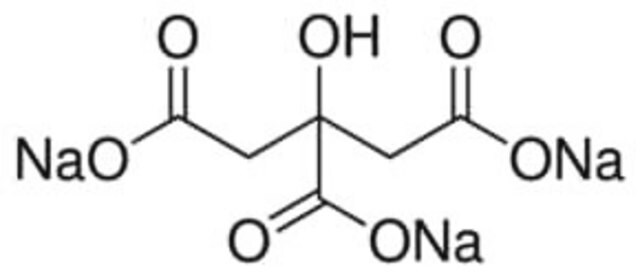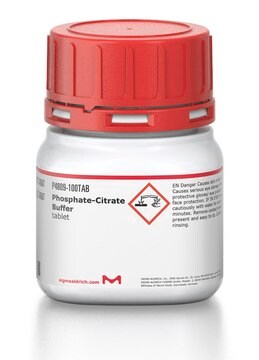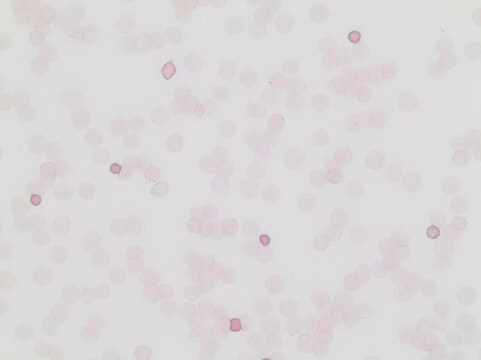C9999
Citrate Buffer, pH 6.0, 10×, Antigen Retriever
for immunohistochemistry
Sinónimos:
1,2,3-Propanetricarboxylic acid, 2-hydroxy-, mixt. with sodium hydroxide (Na(OH)) and sodium 2-hydroxy-1,2,3-propanetricarboxylate
Iniciar sesiónpara Ver la Fijación de precios por contrato y de la organización
About This Item
Código UNSPSC:
12352107
NACRES:
NA.47
Productos recomendados
Aplicación
Citrate Buffer, pH 6.0, 10×, Antigen Retriever has been used as a heat-induced antigen retriever on formalin-fixed paraffin-embedded (FFPE) tissue sections prior to application of antibodies or DNA fluorescent in situ hybridization. In immunohistochemistry (IHC), most commonly used fixatives such as formalin mask tissue antigens (cellular, membrane, and nuclear) by their intrinsic crosslinking. This masking results in poor or no staining in IHC. The use of Citrate buffer, pH 6.0, or other antigen retrieval solutions on FFPE tissue sections improves accessibility of antibodies to tissue antigens.
Nota de preparación
Dilute the Citrate buffer, pH 6.0, 10x, Antigen Retriever 10-fold with water to prepare a 1x Working Solution, e.g., dilute 10 mL of 10x concentrate with 90 mL of water.
Almacenamiento y estabilidad
Store the product at 2–8 °C. Do Not Freeze to prevent possible precipitation.
Otras notas
Occasionally the buffer may contain a yellowish tinge. This is due to preservative and will not affect the function of the buffer.
Store the prepared 1′ Citrate buffer, pH 6.0, Working Solution at 2–8 °C.
Store the prepared 1′ Citrate buffer, pH 6.0, Working Solution at 2–8 °C.
Producto relacionado
Referencia del producto
Descripción
Precios
Palabra de señalización
Warning
Frases de peligro
Consejos de prudencia
Clasificaciones de peligro
Aquatic Chronic 3 - Skin Sens. 1
Código de clase de almacenamiento
12 - Non Combustible Liquids
Clase de riesgo para el agua (WGK)
WGK 2
Punto de inflamabilidad (°F)
Not applicable
Punto de inflamabilidad (°C)
Not applicable
Elija entre una de las versiones más recientes:
¿Ya tiene este producto?
Encuentre la documentación para los productos que ha comprado recientemente en la Biblioteca de documentos.
Los clientes también vieron
Joel L Coble et al.
Human molecular genetics, 26(16), 3212-3220 (2017-06-09)
Diverticulitis is a chronic disease of the colon in which diverticuli, or outpouching through the colonic wall, become inflamed. Although recent observations suggest that genetic factors may play a significant role in diverticulitis, few genes have yet been implicated in
Sumit Agarwal et al.
Translational oncology, 13(7), 100776-100776 (2020-05-19)
Pancreatic ductal adenocarcinoma (PDAC) is an aggressive cancer with an extremely poor prognosis. There is an urgent need to identify new therapeutic targets and also understand the mechanism of PDAC progression that leads to aggressiveness of the disease. To find
Jennifer A Francesconi et al.
Behavioural brain research, 382, 112467-112467 (2020-01-10)
Male and female C57BL/6 J mice were tested on the predator odor response task, where they needed to cross through a chamber of scented bedding to reach a sucrose reward. Following the behavioral testing, mouse brains were immunohistochemically labeled for expression
Talveen S Purba et al.
European journal of cell biology, 96(6), 632-641 (2017-04-18)
Human hair follicle (HF) growth and hair shaft formation require terminal differentiation-associated cell cycle arrest of highly proliferative matrix keratinocytes. However, the regulation of this complex event remains unknown. CIP/KIP family member proteins (p21CIP1, p27KIP1 and p57KIP2) regulate cell cycle
S R Shi et al.
The journal of histochemistry and cytochemistry : official journal of the Histochemistry Society, 43(2), 193-201 (1995-02-01)
Antigen retrieval (AR) incorporating high-temperature microwave (MW) heating of tissue sections before immunostaining is a revolutionary technique that can unmask the antigens in formalin-fixed tissue sections, thus making them available for immunohistochemical staining. Although high temperature is believed to be
Nuestro equipo de científicos tiene experiencia en todas las áreas de investigación: Ciencias de la vida, Ciencia de los materiales, Síntesis química, Cromatografía, Analítica y muchas otras.
Póngase en contacto con el Servicio técnico










